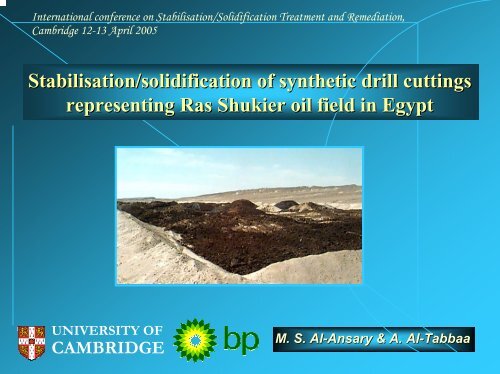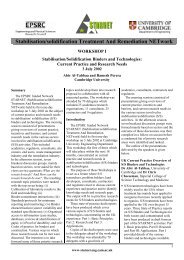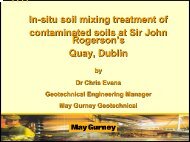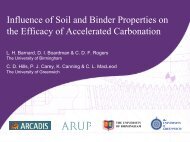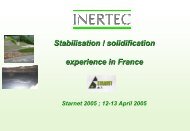Stabilisation/solidification of synthetic drill cuttings ... - Starnet
Stabilisation/solidification of synthetic drill cuttings ... - Starnet
Stabilisation/solidification of synthetic drill cuttings ... - Starnet
- No tags were found...
You also want an ePaper? Increase the reach of your titles
YUMPU automatically turns print PDFs into web optimized ePapers that Google loves.
International conference on <strong>Stabilisation</strong>/Solidification Treatment and Remediation,Cambridge 12-13 April 2005<strong>Stabilisation</strong>/<strong>solidification</strong> <strong>of</strong> <strong>synthetic</strong> <strong>drill</strong> <strong>cuttings</strong>representing Ras Shukier oil field in EgyptUNIVERSITY OFCAMBRIDGEM. S. Al-AnsaryAnsary & A. A Al-Tabbaa
OutlineI. Oil Drill CuttingsII.III.IV.Ras Shukier Case StudyExperimental WorkOngoing programmeV. Conclusion
Drill <strong>cuttings</strong> are heterogeneous wastesthat are generated from petroleum <strong>drill</strong>ing industry• Cla
Drill Cuttingscontaminated withchemicals fromfluid & oilRecycled Recycled fluid fluidDrill Cuttings + fluidDrill fluid Circulation System
Treatment methods for <strong>drill</strong> <strong>cuttings</strong>Leave in place- disturbedCrawler retrievalLeave in place- undisturbedRe-injectionEntombmentRe-spreadingCappingMechanical separationGravel DumpingDistillationBioremediation in situ<strong>Stabilisation</strong>Bio-reactorCombustionLand FarmingSupercritical extractionMechanical DredgingThermal Desorption
II. Ras Shukier Drill CuttingsRas Shukier is an <strong>of</strong>fshore oilproduction site located in theGulf <strong>of</strong> Suez, Red Sea,Egypt. This site generatesapproximately 2,740 tonnes<strong>of</strong> <strong>cuttings</strong> per year. RasShukier consists <strong>of</strong> ninecomplex platforms.
Drilling RigOffshoreOnshoreCuttingBoxManifest byToolpusherService boatManifest byLoad MasterApproved disposal byEnvironmentTransportationWaste Disposal AreaDrill Cuttings
Physical and Chemical Characteristics• Brownish black, sticky with a clayey texture soil.• Distinctive crude odour.• Density ranges between 1.2 and 2.0 g/cm 3 .(w/w)Hydrocarbon%Cr%Zn%Ba%Pb%Cl%Average11.00.10.20.20.1 2.1Max11.80.40.61.20.39.2
Binder SystemA. Conventional BindersB. Novel BindersPortland Cement (PC)MgO cementLimePulverised Fuel Ash (PFA)Blastfurnace Slag (BFS)ZeoliteMicrosilica (silica fume)Cement Kiln Dust (CKDCompost
Sample PreparationWater : Dry binder: 0.6 : 1Dry binder content by weight : 10%, 20% and 30%Binders: either PC only or 1:1 PC:other binderSample size : 50 x 100 mm
Testing ProgramTests at 28 days <strong>of</strong> curing1. Unconfined compressive strength (UCS)2. Leachability (Chloride and Oil)3. Leachate pH4. Microstructure analysis
Microsilica-PC1. Unconfined Compressive Strength (UCS)45004000350030002500200015001000500030%20%10%MgO-Cement 1Compost-PCLime-PCCKD-PCMgO-Cement 2PFA-PCZeolite-PCBFS-PCPCUCS (kPa)
MgOcement 1MgOcement 2Microsilica- PC2. Chloride LeachabilityPCPFA- PCCKD- PCCompost- PCLime- PCZeolite- PCBFS- PC185015501250950Chloride leachate conc. (mg/L)10% 20% 30%
MgOcement 1MgOcement 2Microsilica- PC2. Oil LeachabilityPCPFA- PCCKD- PCCompost- PCLime- PCZeolite- PCBFS- PC1000010001001010% 20% 30%Paraffin oil leachate conc. (mg/L)
3. Leachate pHBinder SystemBinder content10% 20% 30%PC 12.0 12.4 12.6BFS - PC 12.0 12.2 12.4Microsilica - PC 10.5 10.4 10.6Lime - PC12.1 12.5 12.4Compost - PC 11.6 12.1 12.2PFA - PC 12.0 12.1 12.1MgO cement19.911.0 11.0MgO cement2 10.9 12.0 12.0Zeolite - PC 11.6 11.9 11.7CKD- PC 12.0 12.3 12.4
4. Microstructural AnalysisSEM at 28 daysPCMicrosilica - PCLime - PCZeolite - PCCompost - PCMgO cement 2
IV. Ongoing ProgrammeNorth Sea Case StudyBest S/S systems selected for more detailed studyNext mixes to include heavy metalsFor chloride, possibility <strong>of</strong> a low pH cementPelletisation <strong>of</strong> thermally treated <strong>drill</strong> <strong>cuttings</strong>
V. ConclusionDrill cutting is a big problem that the petroleumindustry is keen to find solutionsThe utilisation <strong>of</strong> S/S techniques to treat <strong>drill</strong> <strong>cuttings</strong>by using conventional as well as novel binders indicatedthe following:- UCS <strong>of</strong> the <strong>drill</strong> <strong>cuttings</strong>-binder mixes at 28 dayscovered a wide range <strong>of</strong> feasible applications.
V. Conclusion (contd.)- Chloride leachate concentrations showed a change fromhazardous to non-reactive hazardous waste.- Oil leaching concentrations decreased as the dry bindercontent increased.- The leachate pH values indicated the use <strong>of</strong> lower pH binders.- The microstructural analysis suggested an advanced level <strong>of</strong>hydration.Future work will give more detailed information on therelative performance <strong>of</strong> different binders.
Thank YouMarwa at Ras Shukier oil field May 2003


